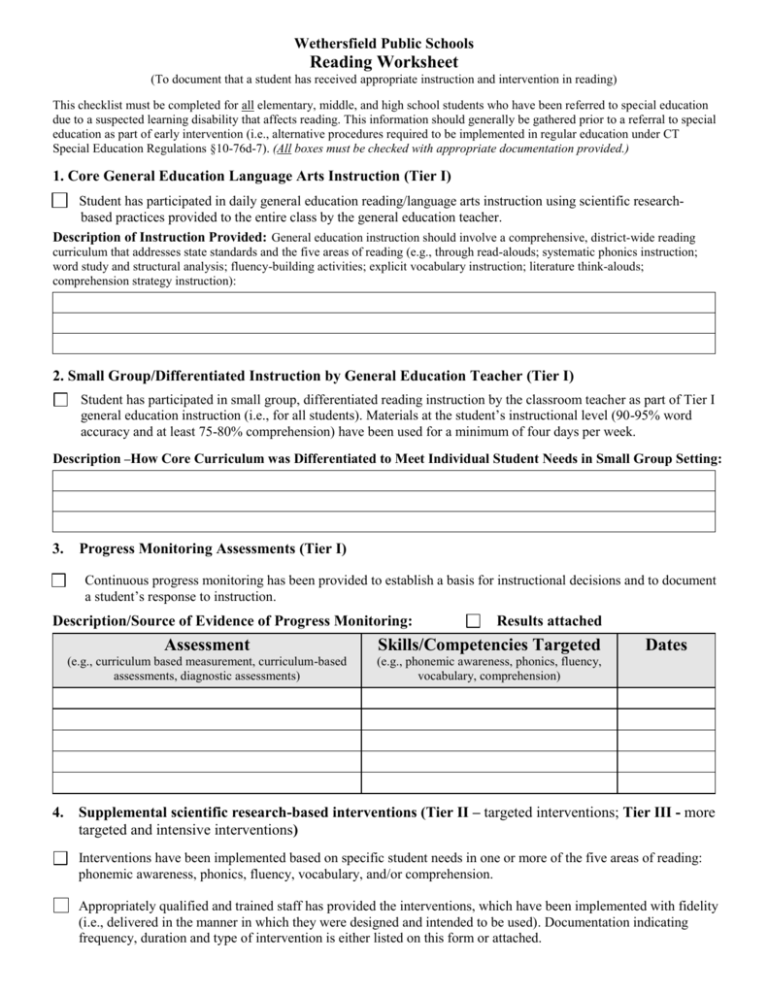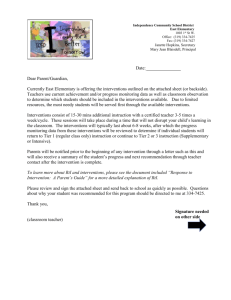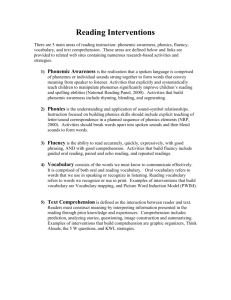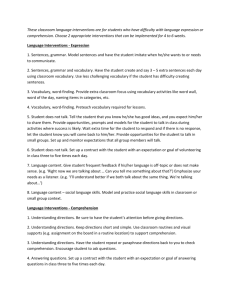General education instruction should involve a comprehensive
advertisement

Wethersfield Public Schools Reading Worksheet (To document that a student has received appropriate instruction and intervention in reading) This checklist must be completed for all elementary, middle, and high school students who have been referred to special education due to a suspected learning disability that affects reading. This information should generally be gathered prior to a referral to special education as part of early intervention (i.e., alternative procedures required to be implemented in regular education under CT Special Education Regulations §10-76d-7). (All boxes must be checked with appropriate documentation provided.) 1. Core General Education Language Arts Instruction (Tier I) Student has participated in daily general education reading/language arts instruction using scientific researchbased practices provided to the entire class by the general education teacher. Description of Instruction Provided: General education instruction should involve a comprehensive, district-wide reading curriculum that addresses state standards and the five areas of reading (e.g., through read-alouds; systematic phonics instruction; word study and structural analysis; fluency-building activities; explicit vocabulary instruction; literature think-alouds; comprehension strategy instruction): 2. Small Group/Differentiated Instruction by General Education Teacher (Tier I) Student has participated in small group, differentiated reading instruction by the classroom teacher as part of Tier I general education instruction (i.e., for all students). Materials at the student’s instructional level (90-95% word accuracy and at least 75-80% comprehension) have been used for a minimum of four days per week. Description –How Core Curriculum was Differentiated to Meet Individual Student Needs in Small Group Setting: 3. Progress Monitoring Assessments (Tier I) Continuous progress monitoring has been provided to establish a basis for instructional decisions and to document a student’s response to instruction. Description/Source of Evidence of Progress Monitoring: Results attached Assessment Skills/Competencies Targeted (e.g., curriculum based measurement, curriculum-based assessments, diagnostic assessments) (e.g., phonemic awareness, phonics, fluency, vocabulary, comprehension) Dates 4. Supplemental scientific research-based interventions (Tier II – targeted interventions; Tier III - more targeted and intensive interventions) Interventions have been implemented based on specific student needs in one or more of the five areas of reading: phonemic awareness, phonics, fluency, vocabulary, and/or comprehension. Appropriately qualified and trained staff has provided the interventions, which have been implemented with fidelity (i.e., delivered in the manner in which they were designed and intended to be used). Documentation indicating frequency, duration and type of intervention is either listed on this form or attached. a. If decoding skills have been identified as an area of weakness: Student’s phonemic awareness has been evaluated and if warranted, targeted interventions have been provided. Student has been provided with systematic, explicit phonics instruction. Student has been provided with regular opportunities to practice learned decoding skills in texts. Teacher has systematically collected progress monitoring data, using valid and reliable measures, to determine the student’s response to the interventions provided. b. If a student’s oral reading fluency has been identified as an area of weakness: Student’s phonics skills have been evaluated and if warranted, targeted interventions have been provided. Student has been provided with regular opportunities to practice reading a variety of text at his/her independent level (at least 96% word accuracy and 90% comprehension). Student has been provided with teacher-directed fluency interventions focused specifically on improving oral reading fluency with connected text. Teacher has systematically collected progress monitoring data, using valid and reliable measures, to determine the student’s response to the interventions provided. c. If a student’s reading comprehension skills have been identified as an area of weakness beyond what can be accounted for by identified decoding and/or reading fluency deficits: Student’s vocabulary skills have been evaluated and if warranted, targeted interventions have been provided, with application to reading comprehension. Student’s broad oral language skills (e.g., listening comprehension) have been evaluated and if warranted, targeted interventions have been provided, with application to reading comprehension. Student has been provided with explicit comprehension interventions (e.g., additional instruction in researchbased comprehension strategies such as summarization and use of graphic organizers; additional building of background knowledge and/or knowledge of text structure) to address his/her specific comprehension needs. Teacher has systematically collected progress monitoring data, using valid and reliable measures, to determine the student’s response to the interventions provided. 5. Lack of sufficient progress to meet age or State-approved grade-level standards (Tiers II/III) The student has not made sufficient progress in the supplemental intervention(s) implemented above despite attempts to improve, individualize and intensify the intervention. Source of Evidence: Attach teacher support and/or intervention team information (including data in numeric and graphic formats) AND complete chart below Scientific research-based interventions used as supplemental and/or intensive interventions. These interventions are in addition to what is provided for all students (i.e., Tier I) Student’s response to interventions Dates Baseline plus at least four additional progress monitoring measurements for each intervention (CBM or other appropriate measure) of intervention implementation NOTE: Please see 2010 Guidelines for Identifying Children with Learning Disabilities for more information regarding instructions on completing the worksheet. (Teacher signature) (Date) (Signature of person(s) responsible for item #5) (Date) ED630 / September 2010 Page 2 of 2 ED630 - Reading Worksheet







